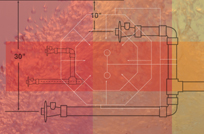Technical Briefing
Designing watershapes of any sort is becoming more and more challenging every day. Where not all that long ago consumers were happy if a pool or spa or fountain or pond simply looked good and operated reliably, there's a new generation of consumers who are much more interested in how these vessels are built and, more specifically, in knowing about how energy efficient they are. This trend is being driven on the one hand by the inevitability of rising utility rates and on the other by legislation such as California's Appliance Efficiency Code (Title 20) - a rule that's attracting the attention of code writers across the country because of the overwhelming importance these days of reducing energy consumption. With that backdrop, this article takes a look at a watershape's main energy consumer and the most basic of all its
From the grandest waterfall to the smallest courtyard fountain, water flowing over an edge is one of the most compelling of all watershaping “looks.” Whether it’s a vanishing edge or a slot overflow or a trough, runnel or waterfall, these effects all use one common concept – that is, the weir. Simply defined, a weir is a barrier or dam placed in a channel behind which fluid backs up and then falls through a notch and down the face of the weir. In most watershaping applications, water travels over the weir’s edge or brink and into some kind of lower basin, trough or pool. Physically and visually, these systems are driven by
Working successfully with hydraulic systems requires two things: Understanding the definitions of the basic factors involved in hydraulic calculations and seeing how those values relate to and influence each other in the real world. The last installment in this series of articles focused on the relationship between flow and velocity with respect to water. The related concept we’ll explore this time takes our understanding of that key relationship a step farther by exploring a specific pair of additional relations summarized by
As watershapes have become increasingly complex, the need for reliable hydraulic designs that maximize efficiency and reliability is now more pressing than it’s ever been, says hydraulics expert Steve Gutai. With this installment of his ongoing series on hydraulics, he launches a sequence of articles that will explore principles behind the fluid mechanics and hydraulics of custom
Backwash valves are the unsung heroes of many a fine hydraulic system. Seldom considered other than when in use, these handy devices simplify filter maintenance, significantly extend filter cycles and even serve to stretch the service lives of a filter’s internal components. Ensuring that level of reliable performance, says hydraulics expert Steve Gutai, is a matter of understanding the role these valves play and selecting the right one for the given application. Backwash valves are simple in concept: They reverse the flow of water through a filter and, in so doing, dislodge dirt and debris that has built up on the surface of and in the filter medium. This procedure has a couple of key benefits in both sand and diatomaceous-earth filters: First, it improves filter performance by breaking up and flushing out the near-solid cakes of dirt and oil particles that build up in the media over time. Second, it prolongs filter cycles and extends the time between major (and messy) cleanings. Third, because they minimize those invasive cleanings, backwashing helps to extend the service lives of a filter’s internal components. For all that, I keep seeing systems in the field in which backwash valves are
Watershape construction is far more sophisticated now than at any time in history. Swimming pools, for instance, are commonly designed to include spas with complex jet manifolds and a wide variety of controllable effects, while vanishing edges, perimeter-overflow details, multiple water levels and various water-in-transit designs are also increasing in popularity. Fountains and waterfalls and the full range of other waterfeatures also are more elaborate, and what all of them require are well-planned systems of valves to control and divert water to all the necessary components, effects and details. These are situations in which valve choice is, in fact, critical to hydraulic-system design. The many types of valves can be separated into three specific categories roughly according to application. There are some that divert water, others that isolate water and still others that
Surge tanks may end up being out of sight, notes hydraulics expert Steve Gutai, but they should never be out of mind as you strive for efficiency and reliability in setting up water-in-transit systems that call for their use. While proper sizing, selection, placement and plumbing are all relatively simple, he adds, bringing them together in just the right way is crucial when it comes to the success of these dynamic installations. In many ways, installing a surge tank is simple. If you get it right, all will be well. As is the case with so many watershape systems, however, getting it wrong can lead to


















